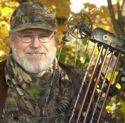This is the second article in a two-part series on white-tailed deer in Kentucky.
Throughout the late 1960’s and early 1970’s, Kentucky’s deer herd grew very slowly, and the harvest continued to be monitored by a mail survey. The herd estimate was about 35,000.
In 1971, archery season went statewide for the first time.
Kentucky’s 1972 deer season consisted of two months of archery hunting, in October and December, and a three-day firearms season in November, timed close to the peak of the rut.

Deer of either sex could be taken by archers, but during the firearms hunt only deer with a forked antler or antlers could be harvested. There is a one deer per hunter, per year, bag limit, and all counties except Jackson and Owsley are open for hunting.
For safety reasons, a mandatory hunter orange regulation was passed by the Kentucky Fish and Wildlife Commission on March 12, 1973. It required all hunters afield during firearms deer hunts to wear solid orange on their head and chest.
Mandatory Deer Check Stations
By the mid-1970s staff biologists were puzzled by the data they were receiving from the deer hunter mail survey. Given the high quality habitat found over two thirds of Kentucky, deer numbers should have been growing faster than the kill data indicated.
They surmise that the herd is being over harvested, or the legal harvest is being under reported. An improved method of recording and tracking harvest is needed, so in 1976, mandatory deer check stations open throughout the state. That season hunters checked in 3,476 deer.
Quota hunts on state and federal areas still make up a large percentage of deer kills — about 50 percent of the statewide harvest.
Deer Management Zones Adopted
From 1978 through 1981, the deer herd starts to take off. Herd estimates climb from 64,000 to 149,000. During the 1981 season hunters check in 14,983 deer, the first time the harvest surpasses 10,000.
In order to manage deer herds on a county-by-county basis since some herds are larger and growing faster, a deer management zoning strategy is adopted. Under this system, each of Kentucky’s 120 counties is assigned a zone status, which determines deer season length and bag limit. There are six deer management zones.
This strategy provides the flexibility needed to encourage greater antlerless harvest pressure in counties where high deer densities are starting to develop, yet still limits or prohibits antlerless take in counties with newly-established, or slow-growing deer populations.
In the early 1980s Kentucky has a 75-day archery season and a three-day November firearms season. Only antlered deer (must have at least one forked or unforked antler that is four inches long or longer) can be harvested.
The season limit is two antlered deer per hunter, but only one of them can be taken with a firearm.
Mountain Counties Get High-Density Stockings
Despite the translocation of hundreds of deer to southeastern Kentucky during the previous 30 years, coupled with restrictive harvest regulations designed to promote population growth, most counties in the region still have deer densities of only two to four animals per square mile.
Harassment and predation by free-ranging dogs, lack of early successional or “edge” habitat, and illegal harvest are cited as reasons for the failure of deer restoration in Appalachia.
Poaching in particular is thought by staff biologists to be the most important factor.
So the decision is made in 1984 to begin a high-density stocking program in which 500 whitetails will be released in each county demonstrating stagnant or slow population growth. The stocking strategy is intended to get enough deer into a county to reach the threshold density necessary for population establishment and growth, even in the presence of considerable illegal harvest pressure.
About 150 deer are trapped each year by the employees at Ballard Wildlife Management Area (WMA), and 200 more at Kentucky State Parks and military bases by a mobile trapping crew of seasonal employees, for the saturated stockings.
In addition to capturing and transporting deer to southeastern Kentucky, the department staff mounts a public education effort with articles, radio and television spots, and talks with sportsmen’s clubs in the region. Articles and project updates appear regularly in the agency’s magazine, to discourage poaching and encourage control of free-ranging dogs.
Population Model Used to Generate Herd Estimates
In 1986, after evaluating several computerized deer population models, deer managers select DEER CAMP. It will be used by inputting harvest data from previous seasons to generate estimates of the number of deer that will be present in a county when the next season opens. This information will then be compared to crop damage complaints and deer/vehicle collision data to formulate county deer zone recommendations for the coming deer season.
For the 1986 season the DEER CAMP population model estimated that there were 206,557 deer in Kentucky. About 175,000 deer hunting permits are purchased for the 1986 season, and 39,520 deer are harvested.
Two years later, for the 1988 deer season, Kentucky has a 92-day archery season and a 10-day gun season. Estill, Knox, Letcher and Perry counties are closed to deer hunting. The herd estimate is 350,000, and there’s a two-deer limit. A set of two deer tags costs $17.50.
During the decade of the 1980s, Kentucky’s deer harvest soars from 9,702 in 1980 to 70,149 by 1989.
Muzzleloader Deer Season
Kentucky’s rich heritage of hunting and target shooting with flintlock and percussion (caplock) rifles was a driving force behind the establishment of a special season for those who wanted to hunt deer with traditional firearms.
Several muzzleloading clubs lobbied the Kentucky Fish and Wildlife Commission, and in November, 1985, a two-day muzzleloader deer season was held in 52 counties. Hunters could take only antlered deer.
Through the years the so-called late season was lengthened, the bag limit liberalized, and eventually moved to mid-December.
By 2004, the late season had expanded from seven to nine days, was open statewide and hunters could take deer of either sex in all four of the state’s deer management zones.
The focus of the late season has always been on harvesting antlerless deer (does) to control herd growth, balances the sex ratio between bucks and does, and helps maintain good body condition and antler development in the herd.
The two-day early muzzleloader deer season debuted in 1990, and is held on the third weekend of October.
One Buck Limit
In a move that will put Kentucky in the record books for decades to come, the one-buck limit was established and phased into the regulations over a three-year period, from 1989 to 1991. This regulation, coupled with the gradual change in hunter attitude away from harvesting immature bucks, increases the number of large antlered bucks in the herd. For decades to come, hunters in every Kentucky county will realistically have a chance at bagging a record-class buck.
As of the 2013-2014 season, Kentucky was ranked fifth behind Wisconsin, Illinois, Iowa and Minnesota for Boone and Crockett Club bucks since 1830, with 432 entries, trailing only Wisconsin and Illinois in the past decade.
Herd Growth Continues
In the 10 years from 1989 to 1999, Kentucky’s deer herd continues to steadily grow, with estimates jumping from 460,000 in 1989 to 610,000 by 1999.
For the 1990-1991 season there are seven deer management zones, a 10-day gun season and 3 1/2-month archery season, which ended on Jan. 15, 1991.
An overall record harvest was set during the 1991-1992 season when 92,934 deer were checked in by hunters. Success rates are on the rise too, by the 1997-1998 season, the combined archery and firearms hunter success rate is 53.9 percent.
Deer Restoration Ends
Throughout the 1990s the mobile trapping team continues catching deer for the high-density stockings in southeastern Kentucky.
In 1999, deer restoration ends in March with the release of the final load of deer in Perry County. After 52 years, 10,096 white-tailed deer have been trapped and re-located around the state. That fall, for the first time, all 120 counties were open to deer hunting. Before that, from 1956 to 1998, one or more counties had been closed, during Kentucky’s deer restoration era.
While some of the deer released in Kentucky’s restocking efforts came from out-of-state sources, including Michigan, New Jersey, Oklahoma, Pennsylvania, Tennessee, and Wisconsin, the overwhelming majority were translocated from in-state trap sites, and their lineage ultimately traces back to early 20th century remnant deer populations in Caldwell, Christian, Lyon, and Trigg Counties.
Hunter Opportunities Expand
For the 1997‐1998 season, archery season for deer expanded, with opening day in early September. A bow hunter observation program was initiated.
In another regulation change, all landowners must check harvested deer.
Kentucky’s Youth-Only firearms season for deer was first held in 1996. The season was created to offer resident and non-resident boys and girls ages 15, and under, an introduction to deer hunting, with the maximum opportunity for success. Youth hunters must be accompanied by an adult who is in position to take immediate control of the youth hunter’s firearm at all times.
Deer of either sex may be taken during the statewide, weekend season.
Telecheck Deer Harvest Reporting System Debuts
Unhappy with the poor data on check cards, and the laborious task of reading them, deer managers go to an automated phone system for reporting deer harvest information.
The Telecheck Deer Harvest Reporting System debuts during the 1999-2000 season. Hunters phone in a harvest of 95,229 deer. The debut of Telecheck, and the unprecedented liberalizations put in place for the 2000-2001 deer season couldn’t come at a better time, as deer managers announce that it’s time to put the brakes on herd growth.
Only twice in the past 24 seasons have hunters taken more does than bucks, which slows herd growth.
For more outdoors news and information, see Art Lander’s Outdoors on KyForward.
In a bold move, which history shows was well timed, gun season is lengthened by six days to 16 days in 89 counties. Hunters in the 45 Zone 1 counties, which have the densest herds, can now take an unlimited number of antlerless deer (does).
The county deer zoning system is also restructured and simplified. Six zones are condensed down to four. The season bag limit is four deer, but only one may be a buck.
In 2002, there was a change in the computer population model used to manage Kentucky’s deer herd. The Downing Reconstruction Model was adopted, and Deer Camp was abandoned. Today, this model is used in all southeastern states. It’s based on the number of bucks, does and fawns in the harvest, allowing deer managers to predict populations.
Era of Record Deer Harvests
The liberalization of deer seasons and bag limits, established for the 2000-2001 season, worked as planned.
During the first decade of the new century, deer herd growth slowed and the harvest trends up and down in a stabilized range, from 106,263 in 2000, to 113,584 in 2009, with a new overall harvest record of 124,752 established in 2004. Every season since the 2000-01 season hunters have checked in more than 100,000 deer.
This past season was the third overall harvest record in the past four years, with hunters checking in a record 131,395 deer in 2012-13 and 144,409 deer in 2013-14.
The 2015-16 season ended on Jan. 18, with an all-time record harvest of 155,725 deer.
With a herd estimate now approaching one million, and an estimated 300,000 deer hunters, the job of deer managers in the future is to maintain the herd’s high quality and continue to provide maximum recreational opportunities, while controlling herds that have expanded into urban/suburban areas.
Social and Economic Impact
Ingrained in Kentucky’s hunting culture, deer hunting brings families and friends together, teaches respect for firearms, and stokes rural economies.
According to the U.S. Fish and Wildlife Service’s 2011 National Survey of Fishing, Hunting and Wildlife-Associated Recreation, 347,000 Kentuckians spent 12.2 million days hunting and spent $798 million on hunting-related activities. Most of those hunters were deer hunters.
The venison that hunters bring home each fall is the most nutritious free-range meat available. It is served at meals throughout the holidays and savored all summer long, smoked over hardwood coals on backyard BBQ grills.
Kentucky’s deer restoration era is a remarkable chapter in the state’s natural history, leaving a legacy of conservation.
It was the result of wise management by state biologists and the financial commitment of Kentucky’s hunters. The time, money and manpower it took to bring back this magnificent native species is staggering.
The epitome of grace, beauty, and wildness, the white-tailed deer flourishes in today’s modern world as a relic of Kentucky’s pioneer past and its proud hunting heritage.
Long live the white-tailed deer in Kentucky.
Art Lander Jr. is outdoors editor for NKyTribune and KyForward. He is a native Kentuckian, a graduate of Western Kentucky University and a life-long hunter, angler, gardener and nature enthusiast. He has worked as a newspaper columnist, magazine journalist and author and is a former staff writer for Kentucky Afield Magazine, editor of the annual Kentucky Hunting & Trapping Guide and Kentucky Spring Hunting Guide, and co-writer of the Kentucky Afield Outdoors newspaper column.






















